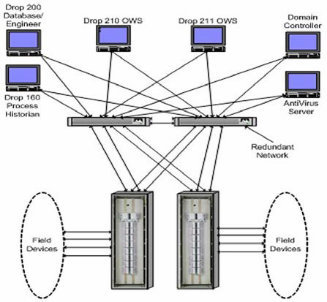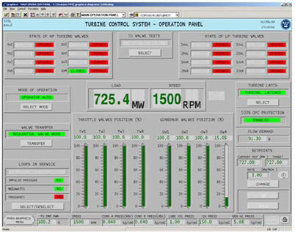Background
Westinghouse has developed common turbine control solutions for pressurized water reactors (PWRs) and boiling water reactors (BWRs). The highly reliable Westinghouse turbine control protection system (TCPS) provides redundant control functions such as speed and overspeed control, load control, steam pressure control, valve testing, frequency control and turbine protection. The base control system can easily be expanded to provide additional functionality such as automatic turbine startup (ATS), moisture separator reheat (MSR) and the generator monitoring and turbine protection system (TPS).
The TCPS is based on the Emerson Ovation® product. The Ovation system is designed for the power industry and is flexible, easy to use and reliable, and provides advanced diagnostics. The Ovation system has no single points of failure that could cause disruptions or downtime. The Ovation TCPS can be a standalone application or can be expanded as part of a plant wide control and information system. The Ovation family of hardware and software can easily be retrofitted to any type of utility plant process equipment, regardless of manufacturer.
The base TCPS system, combined with available electro-mechanical products such as pressure status manifolds, 2/3 trip manifolds, redundant linear-voltage differential transducer (LVDT) assemblies, speed probes and wheels, provides a comprehensive solution to address potential turbine-related problems.
Description

Typical System Architecture
The TCPS communication components consist of two fully redundant fast Ethernet switches that can be configured to allow for fan-out networks or to uplink to an existing Ovation network. The switches can be powered by two separate and independent power sources to provide redundancy and maximum system-fault tolerance. All drops (controllers and workstations) are dual attached to the network for added reliability. The system is designed so that the TCPS controllers will continue to function, even if both switches fail and network communication becomes unavailable.
A typical TCPS will have two redundant controller cabinets: one used for the turbine control system (TCS) and one for the turbine protection system. Also included are two operation workstations that deploy soft controls using dual displays, an engineer’s workstation for configuring the system and an antivirus workstation. Additional functionality is provided by optional software packages and workstations, as required, to provide historian capability and domain controller redundancy, and to address cyber security measures.
The base TCPS consists of two major functions: the operator automatic and overspeed protection. These two subsystems perform all required protective and operator auto functions including overspeed protection, speed control, overspeed trip, pressure control (BWR), load control, sequential valve control, valve transfer, valve testing, feedback loop initiation and remote control.
Additional optional functions can be added in separate redundant controllers as required. These include:
- TPS – This is a dedicated redundant controller that provides fast and effective protection to avoid damaging the turbine. Features of this option are first-out trip logic, median signal selection logic for critical inputs, and diverse overspeed trip that is testable on line.
- MSR Control – The MSR regulates the main steam flow, thereby controlling the MSR outlet temperature to the low-pressure turbine inlet. This control system can be included in the ATS/RSM or OA/OPC controller, or operate as a standalone.
- ATS and Rotor Stress Monitoring (RSM) – RSM is integrated with ATS functions within one controller. ATS/RSM calculates and utilizes rotor stress information and other monitored turbine parameters, then automatically accelerates or loads the unit and alerts the operator about turbine/generator alarm conditions. An expanded graphics package with turbine, generator and auxiliary-system displays is provided with this option.
Integral components in the TCPS are the speed-detector module and valve-positioner module (RVP), which are special inputs/outputs (I/O) designed exclusively for turbine-control applications. The speed-detector modules offer a unique and independent trip subsystem that allows hardwired overspeed protection to safety trip the turbine within 5 milliseconds from either the control system or the emergency terminal speed (ETS) overspeed, even if the redundant controllers are off line. The RVP modules allow automatic calibration of the LVDTs in cold- and hot-plant conditions to account for thermal growth, and provide a redundant interface to the control valve. These special I/O interface cards are fourth generation, and have 40 years of operating experience in the design.
Median selector logic is performed for all critical-control or protection-input control on individual analog inputs to protect against a single point of failure. Each input is read on separate I/O cards (each on a separate communication branch in the controller) to eliminate a single point of failure in the I/O hardware. This approach is used for all critical-control and protection-input parameters.
Once the vital inputs are scanned, the data is used to perform important functions such as overspeed protection, loss of load, and close-intercept valve or fast-valving closure action. These protective programs are executed approximately once every 50 milliseconds.
Operator automatic (OA) is the normal mode of operation. The operator enters a target and rate, which are validated by the system so that they will not damage the unit. Checks include verification that the speed target is not in a known blade resonance range, and that the rate does not violate the maximum allowable rate dictated by the turbine’s mechanical design. After a rate and target are accepted, the operator can start or stop the speed or load ramp using the display graphic interface. The OA then calculates a valve position demand and passes this setpoint to the valve positioner cards from the OA system.
Benefits

Typical Turbine Control System Operator Graphic
- Improved process control, reliability, availability, capacity and operability
- Minimized field tuning and risk of delays at startup following major turbine and plant modifications (e.g., uprate)
- Proven low-risk standardized design
- Expansion capability to include other plant control and information system functionality. Standard solutions are available with the Ovation platform for the nuclear steam supply system, including advanced steam generator water-level control and balance-of-plant controls, rod control, flux mapping and plant computer calculations
- The TCPS design addresses cyber-security regulations
Ovation is a registered trademark of Emerson Process Management. Other names may be trademarks of their respective owners.



